Overview
- Brief Narrative
- Theresienstadt scrip, valued at 500 [eine hundert] kronen, belonging to Gerhard Maschkowski. Gerhard was not interned in the ghetto-labor camp in German occupied Czechoslovakia, but his wife Ursula Naumann and his parents were there several years. Inmates were not allowed to have currency and the SS ordered the Jewish Council to design scrip for use only in the camp. Produced in 7 denominations: 1, 2, 5, 10, 20, 50, 100, it was issued to create a false appearance of normalcy in the camp. There was nothing to obtain with the scrip. Gerhard lived with his parents Arthur and Herta, and brother Siegfried in Elbing, Germany. From 1933, the country was governed by a Nazi dictatorship that persecuted Jews. Siegfried left for Palestine in 1939 and Gerhard was sent to agricultural school. Soon after arrival, Gerhard and the others were sent to Jessenmühle labor camp. In 1941, they were transferred to Neuendorf labor camp. In April 1943, he was deported to Auschwitz, and then to Auschwitz III, Buna-Monowitz. In January 1945, the camp was evacuated. The prisoners spent several months on a death march through Czechoslovakia and Germany. In late April 1945, he was liberated by the Red Army near Breslau, weighing only seventy pounds. He was hospitalized and, after recovering, learned that his parents had survived Theresienstadt. They were reunited in Deggendorf displaced persons camp in Germany.
- Date
-
issue:
1943 January 01
- Geography
-
issue:
Theresienstadt (Concentration camp);
Terezin (Ustecky kraj, Czech Republic)
- Credit Line
- United States Holocaust Memorial Museum Collection, Gift of Gerhard Maschkowski
- Markings
- face, upper center, brown ink : QUITTUNG ÜBER / HUNDERT KRONEN [RECEIPT OF / HUNDRED CROWNS]
face, lower center, brown ink : 100
face, lower center, smaller text than above, brown ink : WER DIESE QUITTUNG VERFÄLSCHT ODER NACHMACHT / ODER GEFÄLSCHTE QUITTUNGEN IN VERKEHR BRINGT. / WIRD STRENGSTENS BESTRAFT [ANYONE WHO FALSIFIES OR DISTORTS OR FAKES THIS RECEIPT, OR COUNTERFEITS RECEIPT, WILL BE STRICTLY PUNISHED]
reverse, upper left in border, serial number, red ink : 013215
reverse, lower right, series number, red ink : C
reverse, lower left and upper right corner, brown ink : 100
reverse, center, brown ink : Quittung / über / HUNDERT KRONEN / THERESIENSTADT, AM 1.JANNER 1943 DER ALTESTE DER JUDEN / IN THERESIENSTADT / Jakob Edelstein [Receipt / of / ONE HUNDRED CROWNS / THERESIENSTADT, ON 1. JANUARY 1943 THE ELDER OF THE JEWS IN THERESIENSTADT Jakob Edelstein] - Contributor
-
Subject:
Gerhard Maschkowski
Designer: Peter Kien
Printer: National Bank of Prague
Issuer: Der Alteste der Juden in Theresienstadt
- Biography
-
Gerhard Maschkowski was born on May 19, 1925 in Elbing, Germany, (now Elbląg, Poland) to Jewish parents, Arthur and Herta Imber Maschkowski. Arthur was born on January 5, 1895, in Gross-Statsin. He served in the German military during World War I (1914-1918), and was injured and lost both eyes. Herta was born on August 16, 1896, in Thorn, Germany. Arthur, and sometimes Herta, worked as a typist for a copy service. Gerhard had an older brother, Siegfried, born on August 23, 1922, in Danzig.. In 1933, the Nazi dictatorship took control of Germany. Policies to persecute the Jewish population were implemented across Germany.
On November 9-10, 1938, Kristallnacht, Gerhard saw Jewish stores looted and burned. He was beaten up in school for being Jewish and then no longer allowed to attend. In 1939, Siegfried left for Palestine. Gerhard’s parents sent him to an agricultural school in Ahlem, supposedly to learn skills to emigrate. But soon after he arrived, Gerhard and the other students were taken to Jessen-Mühle labor camp near Sommerfeld (Lubsko, Poland) to do agricultural and civic forced labor. The farm work was hard but they were well fed. In May 1941, they were transferred to Neuendorf labor camp near Berlin where they dug ditches and graves and did road construction for the city. On April 8, 1943, Gerhard was taken by the Gestapo and sent to Auschwitz concentration camp, arriving there on April 20, 1943. He was shaved, tattooed, and given five items: prisoner uniform cap, jacket, pants, a bowl, and a spoon. Gerhard was selected for forced labor and sent to Auschwitz III - Monowitz (Buna) concentration camp. He was assigned to a work detail for an IG Farben factory, first digging ditches and laying cement. With assistance from kapos, who helped fellow Zionists like Gerhard, he got into the electrician detail, laying cable. He learned to ignore the atrocities such as hangings that were normal parts of camp life. Speaking German was an advantage, which helped keep him on the factory detail. As people died, new ones arrived to take their place. Gerhard was able to earn extra food for cleaning the block leader's area. He sometimes had items to trade with other inmates and he formed a friendship with a fellow prisoner Freddy Diamant, who got food for Gerhard and two friends, Benjamin Fengersch and Elie Hyman. In late 1944, the bombings began near the camp. In January 1945, Soviet forces were approaching and the Germans emptied the camp, sending the prisoners on a four month long death march. Except for a brief stay circa late January in Gleiwitz concentration camp, his group was led from place to place throughout Germany and Czechoslovakia. They were kept moving, either on foot or on a coal train. If you stumbled, you were shot. At one point when it was snowing, they were put in a mine shaft. As the air ran out, people would run outside and were shot. Gerhard and his friends stayed in the back, mouths to the ground, pulling oxygen from the earth. Gerhard became numb with cold, but his friends kept him from freezing to death.
In late April 1945, he was liberated during the march by the Red Army near Breslau (now Wrocław, Poland). Gerhard weighed only seventy pounds and could not walk. He was placed in a Catholic hospital and cared for by nuns. During the several months long recovery, Gerhard befriended a Russian soldier, who showed him stores of food the German occupying forces of Breslau had gathered. Gerhard arranged for much of the food to be transferred to the hospital. After his recovery, Gerhard got a letter telling him that his parents had survived. They had been deported in December 1942 to Theresienstadt ghetto-labor camp in German occupied Czechoslovakia because of Arthur’s special status as a wounded war veteran. The camp was liberated in May 1945. The family reunited and lived in Deggendorf displaced persons camp in Germany. While at Deggendorf, Gerhard met his future wife, Ursula Naumann. Ursula was born in Berlin on December 26, 1925, to a Catholic father and a Jewish mother, Margarete. The whole family was considered Jewish. Margarete, Ursula, and Ursula’s sister Hannelore were interned in Theresienstadt. Their father was deported to Auschwitz, where he perished. In March 1947, Gerhard and Ursula emigrated to the United States aboard the Marine Marlin. They married on May 27, 1947, in the morning before going to work. Margarete and Hannelore joined them in September. Gerhard's parents remained in Germany. Gerhard and Ursula moved to Florida, where Gerhard opened an auto repair shop. They had a daughter and two sons. In 1979, the couple settled in California. Ursula, 80, passed away in April 2005.
Franz Peter Kien was born January 1, 1919, in Varnsdorf, Czechoslovakia (Czech Republic), to Leonard and Olga Frankl Kien. His father Leonard was born in 1886, in Varnsdorf, and was a member of the German-speaking Jewish population in the, the Sudetenalnd, which bordered Germany. Leonard was a textile manufacturer with his own factory. Peter’s mother Olga was born in 1898, in Bzenec, Austro-Hungary (Czech Republic), to Jewish parents. After 1929, the Kien family moved to Brno. Peter enrolled at the German Gymnasium, where he excelled at drawing, painting, and writing. In 1936, he graduated and moved to Prague to study at the Academy of Fine Arts. He also attended the Officina Pragensis, a private graphic design school run by a well-known Jewish artist, Hugo Steiner-Prag.
On September 29, 1938, Germany annexed the Sudetenland. On March 15, 1939, Germany invaded Prague and annexed the Bohemia and Moravia provinces of Czechoslovakia, ruled by a Reich Protector. Jews were banned from participation in government, businesses, and organization, including schools. Peter had to leave the Academy, but continued to study at the Officina Pragensis. He also taught at Vinohrady Synagogue. In September 1940, Peter married Ilse Stranska, who was born on May 9, 1915, in Pilsen, to Jewish parents.
In late September 1941, Reinhard Heydrich, the SS head of RSHA, Reich Main Security Office, became Reich Protector. Soon there were regular deportations of Jews to concentration camps. At the end of November, Theresienstadt concentration and transit camp near Prague got its first shipment of Jewish prisoners. On December 14, Peter was transported to Theresienstadt ghetto-labor camp. He was assigned to the technical department where he worked as a draftsman and designer alongside other artists, including Bedrich Fritta, Leo Haas, and Jiri Lauscher. On July 16, 1942, Peter’s wife Ilse arrived in the camp. On January 30, 1943, Peter’s parents Leonard and Olga were transported from Bzenec to Terezin. Peter was assigned major projects by the Jewish Council that administered the camp for the Germans, such as the scrip receipts used in place of money in the camp. He secretly documented the inmate’s daily life, creating portraits and other drawings, and wrote plays, poems, and an operatic libretto. On October 16, 1944, Peter’s wife Ilse and his parents Leonard and Olga were selected for deportation. Peter volunteered to go with them. Before leaving, Peter and his family were sent to Auschwitz concentration camp in German-occupied Poland. Peter survived the selection process, soon fell ill, likely with typhus, and died at age 25 in late October 1944. His wife and parents were killed at Auschwitz. Some of the work that Peter left with other prisoners or hid at Theresienstadt survived and has been exhibited worldwide.
Physical Details
- Language
- German
- Classification
-
Exchange Media
- Category
-
Money
- Object Type
-
Scrip (aat)
- Physical Description
- Theresienstadt scrip printed on rectangular, watermarked, offwhite paper in black, orange, and red-brown ink. The face has a vignette of Moses, a bearded man with a wrinkled brow, holding 2 stone tablets with the 10 Commandments in Hebrew. To the right is the denomination 100 and German text. The background rectangle has an abstract, repeating pattern. On the right is a wide offwhite border with 100 in the bottom corner below a Star of David. The reverse has a background rectangle with a zigzig pattern with an underprint flourish, overprinted with German text, an engraved signature, and a scrollwork line. The denomination 100 is in the upper right corner. On the left is a wide offwhite border with 100 in the bottom corner below a Star of David in a lined circle. The serial number in red ink is in the upper left corner. The series letter in red ink is in the lower right. There are blue ink marks on the back, creased, worn edges, and adhesive tape on the top and bottom.
- Dimensions
- overall: Height: 3.000 inches (7.62 cm) | Width: 5.875 inches (14.923 cm)
- Materials
- overall : paper, ink
Rights & Restrictions
- Conditions on Access
- No restrictions on access
- Conditions on Use
- No restrictions on use
Keywords & Subjects
- Topical Term
- Concentration camp inmates--Poland--Biography. Death marches--Biography. Holocaust survivors--Unites States--Biography. Holocaust, Jewish (1939-1945)--Germany--Personal narratives, Jewish. Jewish refugees--Germany--Deggendorf--Biography. Slave labor--Poland--Biography. World War, 1939-1945--Conscript labor--Personal narratives, Jewish.
Administrative Notes
- Legal Status
- Permanent Collection
- Provenance
- The Theresienstadt scrip was donated to the United States Holocaust Memorial Museum in 2013 by Gerhard Maschkowski.
- Funding Note
- The cataloging of this artifact has been supported by a grant from the Conference on Jewish Material Claims Against Germany.
- Record last modified:
- 2024-10-03 13:04:39
- This page:
- https://collections.ushmm.org/search/catalog/irn526652
Download & Licensing
In-Person Research
- By Appointment
- Request 21 Days in Advance of Visit
- Plan a Research Visit
- Request to See This Object
Contact Us
Also in Gerhard and Ursula Naumann Maschkowski collection
The collection consists of scrip, documents, and photographs relating to the experiences of Gerhard Maschkowski before the Holocaust in Elbing, Germany, and during the Holocaust in Neuendorf and Auschwitz concentration camps, and of documents, correspondence, and photographic postcards relating to the experiences of Ursula Naumann (later Maschkowski) and her family during the Holocaust in Theresienstadt, and to both Gerhard and Ursula after the war in Deggendorf displaced persons camp, where they met, and in the United States where they later settled.
Date: 1938-2005
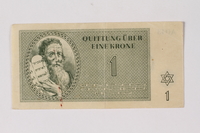
Theresienstadt ghetto-labor camp scrip, 1 krone note, owned by a German Jewish survivor
Object
Theresienstadt scrip, valued at 1 (eine) krone, belonging to Gerhard Maschkowski. Gerhard was not interned in the ghetto-labor camp in German occupied Czechoslovakia, but his wife Ursula Naumann and his parents were there several years. Inmates were not allowed to have currency and the SS ordered the Jewish Council to design scrip for use only in the camp. Produced in 7 denominations: 1, 2, 5, 10, 20, 50, 100, it was issued to create a false appearance of normalcy in the camp. There was nothing to obtain with the scrip. Gerhard lived with his parents Arthur and Herta, and brother Siegfried in Elbing, Germany. From 1933, the country was governed by a Nazi dictatorship that persecuted Jews. Siegfried left for Palestine in 1939 and Gerhard was sent to agricultural school. Soon after arrival, Gerhard and the others were sent to Jessenmühle labor camp. In 1941, they were transferred to Neuendorf labor camp. In April 1943, he was deported to Auschwitz, and then to Auschwitz III, Buna-Monowitz. In January 1945, the camp was evacuated. The prisoners spent several months on a death march through Czechoslovakia and Germany. In late April 1945, he was liberated by the Red Army near Breslau, weighing only seventy pounds. He was hospitalized and, after recovering, learned that his parents had survived Theresienstadt. They were reunited in Deggendorf displaced persons camp in Germany.
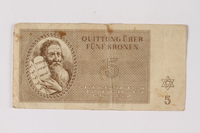
Theresienstadt ghetto-labor camp scrip, 5 kronen note, owned by a German Jewish survivor
Object
Theresienstadt scrip, valued at 5 [funf] kronen, belonging to Gerhard Maschkowski. Gerhard was not interned in the ghetto-labor camp in German occupied Czechoslovakia, but his wife Ursula Naumann and his parents were there several years. Inmates were not allowed to have currency and the SS ordered the Jewish Council to design scrip for use only in the camp. Produced in 7 denominations: 1, 2, 5, 10, 20, 50, 100, it was issued to create a false appearance of normalcy in the camp. There was nothing to obtain with the scrip. Gerhard lived with his parents Arthur and Herta, and brother Siegfried in Elbing, Germany. From 1933, the country was governed by a Nazi dictatorship that persecuted Jews. Siegfried left for Palestine in 1939 and Gerhard was sent to agricultural school. Soon after arrival, Gerhard and the others were sent to Jessenmühle labor camp. In 1941, they were transferred to Neuendorf labor camp. In April 1943, he was deported to Auschwitz, and then to Auschwitz III, Buna-Monowitz. In January 1945, the camp was evacuated. The prisoners spent several months on a death march through Czechoslovakia and Germany. In late April 1945, he was liberated by the Red Army near Breslau, weighing only seventy pounds. He was hospitalized and, after recovering, learned that his parents had survived Theresienstadt. They were reunited in Deggendorf displaced persons camp in Germany.
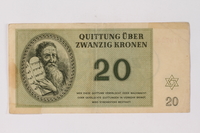
Theresienstadt ghetto-labor camp scrip, 20 kronen note, owned by a German Jewish survivor
Object
Theresienstadt scrip, valued at 20 [zwanzig] kronen, belonging to Gerhard Maschkowski. Gerhard was not interned in the ghetto-labor camp in German occupied Czechoslovakia, but his wife Ursula Naumann and his parents were there several years. Inmates were not allowed to have currency and the SS ordered the Jewish Council to design scrip for use only in the camp. Produced in 7 denominations: 1, 2, 5, 10, 20, 50, 100, it was issued to create a false appearance of normalcy in the camp. There was nothing to obtain with the scrip. Gerhard lived with his parents Arthur and Herta, and brother Siegfried in Elbing, Germany. From 1933, the country was governed by a Nazi dictatorship that persecuted Jews. Siegfried left for Palestine in 1939 and Gerhard was sent to agricultural school. Soon after arrival, Gerhard and the others were sent to Jessenmühle labor camp. In 1941, they were transferred to Neuendorf labor camp. In April 1943, he was deported to Auschwitz, and then to Auschwitz III, Buna-Monowitz. In January 1945, the camp was evacuated. The prisoners spent several months on a death march through Czechoslovakia and Germany. In late April 1945, he was liberated by the Red Army near Breslau, weighing only seventy pounds. He was hospitalized and, after recovering, learned that his parents had survived Theresienstadt. They were reunited in Deggendorf displaced persons camp in Germany.
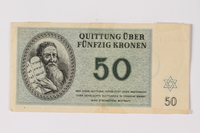
Theresienstadt ghetto-labor camp scrip, 50 kronen note, owned by a German Jewish survivor
Object
Theresienstadt scrip, valued at 50 [funfzig] kronen, belonging to Gerhard Maschkowski. Gerhard was not interned in the ghetto-labor camp in German occupied Czechoslovakia, but his wife Ursula Naumann and his parents were there several years. Inmates were not allowed to have currency and the SS ordered the Jewish Council to design scrip for use only in the camp. Produced in 7 denominations: 1, 2, 5, 10, 20, 50, 100, it was issued to create a false appearance of normalcy in the camp. There was nothing to obtain with the scrip. Gerhard lived with his parents Arthur and Herta, and brother Siegfried in Elbing, Germany. From 1933, the country was governed by a Nazi dictatorship that persecuted Jews. Siegfried left for Palestine in 1939 and Gerhard was sent to agricultural school. Soon after arrival, Gerhard and the others were sent to Jessenmühle labor camp. In 1941, they were transferred to Neuendorf labor camp. In April 1943, he was deported to Auschwitz, and then to Auschwitz III, Buna-Monowitz. In January 1945, the camp was evacuated. The prisoners spent several months on a death march through Czechoslovakia and Germany. In late April 1945, he was liberated by the Red Army near Breslau, weighing only seventy pounds. He was hospitalized and, after recovering, learned that his parents had survived Theresienstadt. They were reunited in Deggendorf displaced persons camp in Germany.
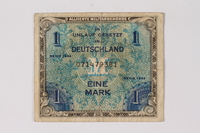
Allied Military Authority currency, 1 mark, for use in Germany, acquired by a German Jewish survivor
Object
Allied Military Authority currency, 1 mark, for use in Germany, acquired by Gerhard Maschkowski, presumably while living in Deggendorf displaced persons camp after the war. Gerhard lived with his parents Arthur and Herta, and brother Siegfried in Elbing, Germany. From 1933, the country was governed by a Nazi dictatorship that persecuted Jews. Siegfried left for Palestine in 1939 and Gerhard was sent to agricultural school. Soon after arrival, Gerhard and the others were sent to Jessenmühle labor camp. In 1941, they were transferred to Neuendorf labor camp. In April 1943, he was deported to Auschwitz, and then to Auschwitz III, Buna-Monowitz. In January 1945, the camp was evacuated. The prisoners spent several months on a death march through Czechoslovakia and Germany. In late April 1945, he was liberated by the Red Army near Breslau, weighing only seventy pounds. He was hospitalized and, after recovering, learned that his parents had survived Theresienstadt. They were reunited in Deggendorf displaced persons camp in Germany.
Gerhard Maschkowski collection
Document
Consists of documents and copies related to the Holocaust experiences of Gerhard Maschkowski, originally of Elbing, Germany. Includes a poem written on the occasion of his 1938 bar mitzvah, identity cards, and information about his experiences in Neuendorf and in Auschwitz. Also includes documents related to Ursula Naumann Maschkowski, including photographic postcards of Theresienstadt and postcards sent to the Naumann family while they were imprisoned there. Also includes material related to the Deggendorf displaced persons camp, where Gerhard and Ursula met; photographic print: black and white image of men and women standing in front of and inside boxcar; captioned on verso: "February 1947 on the way from Munich to Bremerhave to the U.S."; in English; donor is one of the men standing in the doorway (he thinks he is on the far right).



